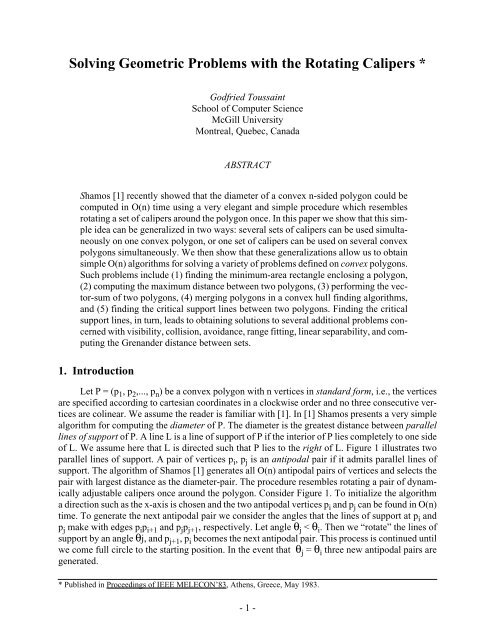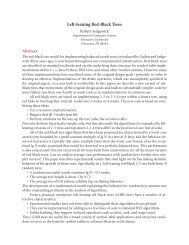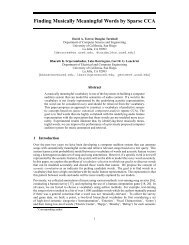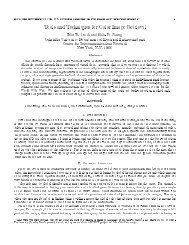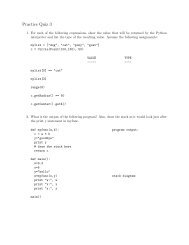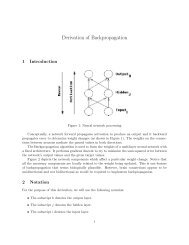Solving Geometric Problems with the Rotating Calipers *
Solving Geometric Problems with the Rotating Calipers *
Solving Geometric Problems with the Rotating Calipers *
You also want an ePaper? Increase the reach of your titles
YUMPU automatically turns print PDFs into web optimized ePapers that Google loves.
<strong>Solving</strong> <strong>Geometric</strong> <strong>Problems</strong> <strong>with</strong> <strong>the</strong> <strong>Rotating</strong> <strong>Calipers</strong> *<br />
Godfried Toussaint<br />
School of Computer Science<br />
McGill University<br />
Montreal, Quebec, Canada<br />
ABSTRACT<br />
Shamos [1] recently showed that <strong>the</strong> diameter of a convex n-sided polygon could be<br />
computed in O(n) time using a very elegant and simple procedure which resembles<br />
rotating a set of calipers around <strong>the</strong> polygon once. In this paper we show that this simple<br />
idea can be generalized in two ways: several sets of calipers can be used simultaneously<br />
on one convex polygon, or one set of calipers can be used on several convex<br />
polygons simultaneously. We <strong>the</strong>n show that <strong>the</strong>se generalizations allow us to obtain<br />
simple O(n) algorithms for solving a variety of problems defined on convex polygons.<br />
Such problems include (1) finding <strong>the</strong> minimum-area rectangle enclosing a polygon,<br />
(2) computing <strong>the</strong> maximum distance between two polygons, (3) performing <strong>the</strong> vector-sum<br />
of two polygons, (4) merging polygons in a convex hull finding algorithms,<br />
and (5) finding <strong>the</strong> critical support lines between two polygons. Finding <strong>the</strong> critical<br />
support lines, in turn, leads to obtaining solutions to several additional problems concerned<br />
<strong>with</strong> visibility, collision, avoidance, range fitting, linear separability, and computing<br />
<strong>the</strong> Grenander distance between sets.<br />
1. Introduction<br />
Let P = (p 1 , p 2 ,..., p n ) be a convex polygon <strong>with</strong> n vertices in standard form, i.e., <strong>the</strong> vertices<br />
are specified according to cartesian coordinates in a clockwise order and no three consecutive vertices<br />
are colinear. We assume <strong>the</strong> reader is familiar <strong>with</strong> [1]. In [1] Shamos presents a very simple<br />
algorithm for computing <strong>the</strong> diameter of P. The diameter is <strong>the</strong> greatest distance between parallel<br />
lines of support of P. A line L is a line of support of P if <strong>the</strong> interior of P lies completely to one side<br />
of L. We assume here that L is directed such that P lies to <strong>the</strong> right of L. Figure 1 illustrates two<br />
parallel lines of support. A pair of vertices p i , p j is an antipodal pair if it admits parallel lines of<br />
support. The algorithm of Shamos [1] generates all O(n) antipodal pairs of vertices and selects <strong>the</strong><br />
pair <strong>with</strong> largest distance as <strong>the</strong> diameter-pair. The procedure resembles rotating a pair of dynamically<br />
adjustable calipers once around <strong>the</strong> polygon. Consider Figure 1. To initialize <strong>the</strong> algorithm<br />
a direction such as <strong>the</strong> x-axis is chosen and <strong>the</strong> two antipodal vertices p i and p j can be found in O(n)<br />
time. To generate <strong>the</strong> next antipodal pair we consider <strong>the</strong> angles that <strong>the</strong> lines of support at p i and<br />
p j make <strong>with</strong> edges p i p i+1 and p j p j+1 , respectively. Let angle θ j < θ i . Then we “rotate” <strong>the</strong> lines of<br />
support by an angle θj, and p j+1 , p i becomes <strong>the</strong> next antipodal pair. This process is continued until<br />
we come full circle to <strong>the</strong> starting position. In <strong>the</strong> event that θ j = θ i three new antipodal pairs are<br />
generated.<br />
* Published in Proceedings of IEEE MELECON’83, A<strong>the</strong>ns, Greece, May 1983.<br />
- 1 -
p i+2<br />
p i+1<br />
θ i<br />
p j<br />
p i<br />
Fig. 1<br />
In this paper we show that this simple idea can be generalized in two ways: several sets of<br />
calipers can be used on one polygon or one pair of calipers can be used on several polygons. We<br />
<strong>the</strong>n show that <strong>the</strong>se generalizations provide simple O(n) solutions to a variety of geometrical<br />
problems defined on convex polygons. Such problems include <strong>the</strong> minimum-area enclosing rectangle,<br />
<strong>the</strong> maximum distance between sets, <strong>the</strong> vector sum of two convex polygons, merging convex<br />
polygons, and finding <strong>the</strong> critical support lines of linearly separable sets. The last problem, in<br />
turn, has applications to problems concerning visibility, collision avoidance, range fitting, linear<br />
separability, and computing <strong>the</strong> Grenander distance between sets.<br />
2. The Smallest-Area Enclosing Rectangle<br />
θ j<br />
p j+1<br />
p j+2<br />
This problem has received attention recently in <strong>the</strong> image processing literature and has applications<br />
in certain packing and optimal layout problems [2] as well as automatic tariffing in goodstraffic<br />
[3]. Freeman and Shapira [2] prove <strong>the</strong> following crucial <strong>the</strong>orem for solving this problem<br />
Theorem 2.1: The rectangle of minimum area enclosing a convex polygon has a side collinear<br />
<strong>with</strong> one of <strong>the</strong> edges of <strong>the</strong> polygon.<br />
The algorithm presented in [2] constructs a rectangle in O(n) time for each edge of P and selects<br />
<strong>the</strong> smallest of <strong>the</strong>se for a total running time of O(n 2 ).<br />
This problem can be solved in O(n) time using two pairs of calipers orthogonal to each o<strong>the</strong>r.<br />
Let L s (p i ) denote <strong>the</strong> directed line of support of <strong>the</strong> polygon at vertex p i such that P is to <strong>the</strong> right<br />
of <strong>the</strong> line. Let L(p i , p j ) denote <strong>the</strong> line through p i and p j . The first step consists of finding <strong>the</strong> vertices<br />
<strong>with</strong> <strong>the</strong> minimum and maximum x and y coordinates. Let <strong>the</strong>se vertices be denoted by p i , p k ,<br />
p l , and p j , respectively, and refer to Figure 2. We next construct L s (p j ) and L s (p l ) as <strong>the</strong> first set of<br />
calipers in <strong>the</strong> x direction, and L s (p i ), L s (p k ) as <strong>the</strong> second set of calipers in a direction orthogonal<br />
- 2 -<br />
p i<br />
θ i<br />
θ l<br />
p j<br />
p l<br />
θ j<br />
Fig. 2<br />
θ k<br />
p k
q j+1<br />
to that of <strong>the</strong> first set. All this can be done in O(n) time. As in Shamos’ diameter algorithm we now<br />
have four, instead of two, angles to consider θ i , θ j , θ k and θ l . Let θ i = min{θ i , θ j , θ k, θ l }. We “rotate”<br />
<strong>the</strong> four lines of support by an angle θ i , L(p i ,p i+1 ) forms <strong>the</strong> base line of <strong>the</strong> rectangle associated<br />
<strong>with</strong> edge p i p i+1 and <strong>the</strong> corners of <strong>the</strong> rectangle can be computed easily in O(1) time from <strong>the</strong><br />
coordinates of p i , p i+1 , p j , p k and p l . We now have a new set of angles and <strong>the</strong> procedure is repeated<br />
until we scan <strong>the</strong> entire polygon. The area of each rectangle can be computed in constant time in<br />
this way resulting in a total running time of O(n). Ano<strong>the</strong>r O(n) algorithm that implements this idea<br />
using a data structure known as a star is described in [4].<br />
3. The Maximum Distance Between Two Convex Polygons<br />
φ j<br />
Fig. 3<br />
p i<br />
q j<br />
Let P = (p 1 , p 2 ,..., p n ) and Q = (q 1 , q 2 ,..., q n ) be two convex polygons. The maximum distance<br />
between P and Q, denoted by d max (P,Q), is defined as<br />
dmax (P,Q) =<br />
max<br />
{d(pi , qj )} i,j = 1, 2,..., n,<br />
i, j<br />
where d(pi , qj ) is <strong>the</strong> euclidean distance between pi and qj . This distance measure has applications<br />
in cluster analysis [5]. A ra<strong>the</strong>r complicated O(n) algorithm for this problem appears in [6]. However,<br />
a very simple solution can be obtained by using a pair of calipers as in Figure 3. In Figure 3<br />
<strong>the</strong> parallel lines of support Ls (qj ) and Ls (pi ) have opposite directions and thus pi and qj are an antipodal<br />
pair between <strong>the</strong> sets P and Q. The two lines of support define two angles θi and φj , and<br />
<strong>the</strong> algorithm proceeds as in <strong>the</strong> diameter problem of Shamos [1]. Note that dmax (P,Q) ≠ diameter<br />
(P ∪ Q) in general and thus we cannot use <strong>the</strong> diameter algorithm on P ∪ Q to solve this problem.<br />
For fur<strong>the</strong>r details <strong>the</strong> reader is referred to [7].<br />
- 3 -<br />
P<br />
θ i<br />
Q<br />
p i+1<br />
p i+2
p i+1<br />
q j+1<br />
p i+2<br />
4. The Vector Sum of Two Convex Polygons<br />
Consider two convex polygons P and Q. Given a point r = (x r , y r ) ε P and a point s = (x s , y s )<br />
ε Q, <strong>the</strong> vector sum of r and s, denoted by r ⊕ s is a point on <strong>the</strong> plane t = (x r + x s , y r + y s ). The<br />
vector sum of <strong>the</strong> two sets P and Q, denoted as P ⊕ Q is <strong>the</strong> set consisting of all <strong>the</strong> elements obtained<br />
by adding every point in Q to every point in P. Vector sums of polygons and polyhedra have<br />
applications in collision avoidance problems [8]. The following <strong>the</strong>orems make <strong>the</strong> problem computable.<br />
Theorem 4.1: P ⊕ Q is a convex polygon.<br />
Theorem 4.2: P ⊕ Q has no more than 2n vertices.<br />
Theorem 4.3: The vertices of P ⊕ Q are vector sums of <strong>the</strong> vertices of P and Q.<br />
These <strong>the</strong>orems suggest <strong>the</strong> following algorithms for computing P ⊕ Q. First compute p i ⊕<br />
q j , for i, j = 1, 2,..., n to obtain n 2 candidates for <strong>the</strong> vertices of P ⊕ Q. Then apply an O(n log n)<br />
convex hull algorithm to <strong>the</strong> candidates. The total running time of such an algorithm is O(n 2 log n).<br />
We now show that P ⊕ Q can be computed in O(n) time using <strong>the</strong> rotating calipers. Two<br />
vertices p i ε P and q j ε Q that admit parallel lines of support in <strong>the</strong> same direction as illustrated in<br />
Figure 4 will be referred to as a co-podal pair. The following <strong>the</strong>orem allows us to search only copodal<br />
pairs of P and Q in constructing P ⊕ Q.<br />
Theorem 4.4: The vertices of P ⊕ Q are vector sums of co-podal pairs of P and Q.<br />
φ j<br />
θ i<br />
q j<br />
p i<br />
Fig. 4<br />
- 4 -<br />
P<br />
Q
φ j<br />
q j<br />
Finally, <strong>the</strong>orem 4.5 allows us to use <strong>the</strong> rotating calipers to construct P ⊕ Q while searching<br />
<strong>the</strong> co-podal pairs of vertices.<br />
Theorem 4.5: Let z k = p i ⊕ q j denote <strong>the</strong> vertex of P ⊕ Q being considered. Then <strong>the</strong> succeeding<br />
vertex z k+1 = p i ⊕ q j+1 if φ j < θ i , z k+1 = p i+1 ⊕ q j if θ i < φ j , and z k+1 = p i+1 ⊕ q j+1 if θ i = φ j .<br />
Thus, each vertex of P ⊕ Q can be constructed in O(1) time after an O(n) initialization step,<br />
and since <strong>the</strong>re are at most 2n such vertices, O(n) time suffices to compute P ⊕ Q.<br />
5. Merging Convex Hulls<br />
q j+1<br />
q j-1<br />
Q<br />
A typical divide-and-conquer approach to finding <strong>the</strong> convex hull of a set of n points on <strong>the</strong><br />
plane consists of sorting <strong>the</strong> points along <strong>the</strong> x axis and subsequently merging bigger and bigger<br />
convex polygons until one final convex polygon is obtained [9]. Performing <strong>the</strong> merge in linear<br />
time will guarantee an O(n log n) upper bound on <strong>the</strong> complexity of <strong>the</strong> entire process. Merging<br />
two convex polygons P, Q consists of essentially finding two pairs of vertices p i , p j and q k , q l such<br />
that <strong>the</strong> new edges p i q k and q l p j , toge<strong>the</strong>r <strong>with</strong> <strong>the</strong> two outer chains q k , q k+1 ,..., q l and p j , p j+1 ,..., p i<br />
form <strong>the</strong> convex hull of P ∪ Q. An edge such as p i q k is called a bridge and <strong>the</strong> vertices making up<br />
a bridge (such as p i and q k ) are referred to as bridge points. While O(n) algorithms exist for finding<br />
<strong>the</strong> bridges of two disjoint convex polygons [9], we show here that <strong>the</strong> bridges can also be computed<br />
very simply <strong>with</strong> <strong>the</strong> rotating calipers.<br />
- 5 -<br />
θi<br />
Fig. 5<br />
p i<br />
p i+2<br />
P<br />
p i-1
The following <strong>the</strong>orem leads to <strong>the</strong> desired algorithm.<br />
Theorem 5.1: Two vertices p i ε P and q j ε Q are bridge points if, and only if, <strong>the</strong>y form a co-podal<br />
pair and <strong>the</strong> vertices p i-1 , p i+1 , q j-1 , q j+1 all lie on <strong>the</strong> same side of L(p i , q j ).<br />
For example, in Figure 5 p i and q j are co-podal but q j+1 lies above L(p i , q j ). Hence p i q j is not<br />
a bridge. A simple algorithm for finding <strong>the</strong> bridges now becomes clear. As <strong>the</strong> co-podal pairs are<br />
being generated during “caliper rotation” we merely test <strong>the</strong> four adjacent vertices of <strong>the</strong> co-podal<br />
vertices to determine if <strong>the</strong>y lie on <strong>the</strong> same side of <strong>the</strong> line collinear <strong>with</strong> <strong>the</strong> co-podal vertices,<br />
and we stop when two bridges have been found. Thus we can determine whe<strong>the</strong>r a co-podal pair is<br />
a bridge in O(1) time and <strong>the</strong> entire algorithm runs in O(n) time.<br />
6. Finding Critical Support Lines<br />
Given two disjoint convex polygons P and Q a critical support line is a line L(p i , q j ) such that<br />
it is a line of support for P at p i , for Q at q j , and such that P and Q lie on opposite sides of L(p i , q j ).<br />
Critical support (CS) lines have applications in a variety of problems.<br />
6.1 Visibility<br />
q j-2<br />
p i+1<br />
p i<br />
q j-1<br />
Q<br />
P<br />
Fig. 6<br />
- 6 -<br />
p i-1<br />
q j<br />
q j+1<br />
p i-2
A typical problem in two-dimensional graphics consists of computing all visibility lists of a<br />
set of objects for a tour or a path taken on <strong>the</strong> plane by an observer [10]. The first step of an algorithm<br />
for solving this task consists of partitioning <strong>the</strong> plane into regions R i such that <strong>the</strong> visibility<br />
list is <strong>the</strong> same for an observer stationed anywhere in some fixed region. For two convex polygons<br />
<strong>the</strong> two CS lines partition <strong>the</strong> plane into <strong>the</strong> required visibility regions.<br />
6.2 Collision avoidance<br />
Visibility and collision avoidance problems are closely related [11]. Given two convex polygons<br />
P and Q we may ask whe<strong>the</strong>r Q can be translated by an arbitrary amount in a specified direction<br />
<strong>with</strong>out “colliding” <strong>with</strong> P. The CS lines provide an answer to this question.<br />
6.3 Range fitting and linear separability<br />
Both of <strong>the</strong>se problems involve finding a line that separates two convex polygons [12]. The<br />
critical support lines provide one solution to <strong>the</strong>se problems. Consider Figure 6, where L(p i , q j ) and<br />
L(p i-2 ,q j-2 ) are <strong>the</strong> two CS lines. Denote <strong>the</strong>ir intersection by l*. We can choose as our separating<br />
line that line that goes through l* and bisects angle p i l*q j-2 .<br />
6.4 The Grenander distance<br />
Given two disjoint convex polygons P and Q <strong>the</strong>re are many ways of defining <strong>the</strong> distance<br />
between P and Q. One method already discussed is d max (P,Q). Grenander [13] uses a distance measure<br />
based on CS lines. Let LE(p i , p j ) denote <strong>the</strong> sum of <strong>the</strong> edge lengths of <strong>the</strong> polygonal chain p i ,<br />
p i+1 ,..., p j-1 , p j and refer to Figure 6. The distance between P and Q would be<br />
d sep (P, Q) = d(p i , q j ) + d(p i-2 , q j-2 ) - LE(p i-2 , p i ) - LE(q j-2 , q j ).<br />
Clearly <strong>the</strong> computation of d sep is dominated by <strong>the</strong> computation of CS lines.<br />
6.5 Computing <strong>the</strong> CS lines<br />
Theorem 6.1: Two vertices p i ε P and q j ε Q determine a critical support line if, and only if, <strong>the</strong>y<br />
form an antipodal pair and p i+1 , p i-1 lie on one side of L(p i , q j ) while q j-1 , q j+1 lie on <strong>the</strong> o<strong>the</strong>r side<br />
of L(p i , q j ).<br />
The above <strong>the</strong>orem allows us to proceed as for finding bridge points. We can determine if an<br />
antipodal pair is a CS line pair in O(1) time for a total running time O(n). Thus all <strong>the</strong> problems<br />
mentioned in section 6 can also be solved simply in O(n) time using <strong>the</strong> “rotating calipers”.<br />
7. Conclusion<br />
In section 3 <strong>the</strong> problem of computing d max (P, Q) was solved <strong>with</strong> <strong>the</strong> rotating calipers. One<br />
naturally considers <strong>the</strong> alternate problem of computing<br />
dmin (P, Q) = min {d(pi , pj )} i, j = 1, 2,..., n.<br />
i, j<br />
- 7 -
It turns out however that <strong>the</strong> pair of vertices determining d min , surprisingly, is nei<strong>the</strong>r a co-podal<br />
nor an antipodal pair and thus <strong>the</strong> techniques used <strong>with</strong> success on d max fail on d min . Finding an<br />
O(n) algorithm for <strong>the</strong> latter problem remains an open question.<br />
The field of computational geometry is in need of general principles and methodologies that<br />
can be used to solve large classes of problems. Shamos [1] established that <strong>the</strong> Voronoi diagram is<br />
one such general structure that can be used to solve a variety of geometric problems efficiently.<br />
The results of this paper would indicate that <strong>the</strong> “rotating calipers” are ano<strong>the</strong>r general tool for<br />
solving geometric problems.<br />
8. References<br />
[1] M.I. Shamos, “Computational geometry”, Ph.D. <strong>the</strong>sis, Yale University, 1978.<br />
[2] H. Freeman and R. Shapira, “Determining <strong>the</strong> minimum-area encasing rectangle for an<br />
arbitrary closed curve”, Comm. A.C.M., Vol. 18, July 1975, pp. 409-413.<br />
[3] F.C.A. Groen et al., “The smallest box around a package”, Tech. Report, Delft University<br />
of Technology.<br />
[4] G.T. Toussaint, “Pattern recognition and geometrical complexity”, Proc. Fifth International<br />
Conference on Pattern Recognition, Miami Beach, December 1980, pp. 1324-<br />
1347.<br />
[5] R.O. Duda and P.E. Hart, Pattern Classification and Scene Analysis, Wiley, New York,<br />
1973.<br />
[6] B.K Bhattacharya and G.T. Toussaint, “Efficient algorithms for computing <strong>the</strong> maximum<br />
distance between two finite planar sets”, Journal of Algorithms, in press.<br />
[7] G.T. Toussaint and J.A. McAlear, “A simple O(n log n) algorithm for finding <strong>the</strong> maximum<br />
distance between two finite planar sets”, Pattern Recognition Letters, Vol. 1, October<br />
1982, pp. 21-24.<br />
[8] T. Lozano-Perez, “An algorithm for planning collision-free paths among polyhedral obstacles”,<br />
Comm. ACM, Vol. 22, 1979, pp. 560-570.<br />
[9] F.P. Preparata and S. Hong, “Convex hulls of finite sets of points in two and three dimensions”,<br />
Comm. ACM, Vol. 20, 1977, pp. 87-93.<br />
[10] H. Edelsbrunner et al., “Graphics in flatland: a case study”, Tech. Rept., University of<br />
Waterloo, CS-82-25, August 1982.<br />
[11] L.J. Guibas and F.F. Yao, “On translating a set of rectangles”, Proc. of <strong>the</strong> Twelfth Annual<br />
ACM Symposium on Theory of Computing, Los Angeles, April 1980, pp. 154-160.<br />
[12] J. O’Rourke, “An on-line algorithm for fitting straight lines between data ranges”, Comm.<br />
ACM, Vol. 24, September 1981, pp. 574-578.<br />
[13] U. Grenander, Pattern Syn<strong>the</strong>sis, Springer-Verlag, New York, 1976.<br />
- 8 -


